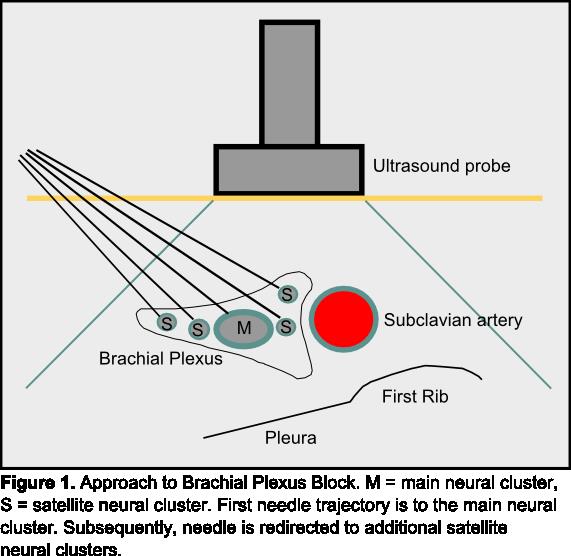[1]
Kulenkampff D. BRACHIAL PLEXUS ANAESTHESIA: ITS INDICATIONS, TECHNIQUE, AND DANGERS. Annals of surgery. 1928 Jun:87(6):883-91
[PubMed PMID: 17865904]
[2]
la Grange P, Foster PA, Pretorius LK. Application of the Doppler ultrasound bloodflow detector in supraclavicular brachial plexus block. British journal of anaesthesia. 1978 Sep:50(9):965-7
[PubMed PMID: 708565]
[3]
Kapral S, Krafft P, Eibenberger K, Fitzgerald R, Gosch M, Weinstabl C. Ultrasound-guided supraclavicular approach for regional anesthesia of the brachial plexus. Anesthesia and analgesia. 1994 Mar:78(3):507-13
[PubMed PMID: 8109769]
[4]
Brown DL, Cahill DR, Bridenbaugh LD. Supraclavicular nerve block: anatomic analysis of a method to prevent pneumothorax. Anesthesia and analgesia. 1993 Mar:76(3):530-4
[PubMed PMID: 8452261]
[5]
Neal JM, Gerancher JC, Hebl JR, Ilfeld BM, McCartney CJ, Franco CD, Hogan QH. Upper extremity regional anesthesia: essentials of our current understanding, 2008. Regional anesthesia and pain medicine. 2009 Mar-Apr:34(2):134-70. doi: 10.1097/AAP.0b013e31819624eb. Epub
[PubMed PMID: 19282714]
Level 3 (low-level) evidence
[6]
Abell DJ, Barrington MJ. Pneumothorax after ultrasound-guided supraclavicular block: presenting features, risk, and related training. Regional anesthesia and pain medicine. 2014 Mar-Apr:39(2):164-7. doi: 10.1097/AAP.0000000000000045. Epub
[PubMed PMID: 24496168]
[7]
Techasuk W, González AP, Bernucci F, Cupido T, Finlayson RJ, Tran DQ. A randomized comparison between double-injection and targeted intracluster-injection ultrasound-guided supraclavicular brachial plexus block. Anesthesia and analgesia. 2014 Jun:118(6):1363-9. doi: 10.1213/ANE.0000000000000224. Epub
[PubMed PMID: 24842181]
Level 1 (high-level) evidence
[8]
Soares LG, Brull R, Lai J, Chan VW. Eight ball, corner pocket: the optimal needle position for ultrasound-guided supraclavicular block. Regional anesthesia and pain medicine. 2007 Jan-Feb:32(1):94-5
[PubMed PMID: 17196502]
[9]
Duggan E, El Beheiry H, Perlas A, Lupu M, Nuica A, Chan VW, Brull R. Minimum effective volume of local anesthetic for ultrasound-guided supraclavicular brachial plexus block. Regional anesthesia and pain medicine. 2009 May-Jun:34(3):215-8. doi: 10.1097/AAP.0b013e31819a9542. Epub
[PubMed PMID: 19587618]
[10]
Gadsden J, Gratenstein K, Hadzic A. Intraneural injection and peripheral nerve injury. International anesthesiology clinics. 2010 Fall:48(4):107-15. doi: 10.1097/AIA.0b013e3181f89b10. Epub
[PubMed PMID: 20881530]
[11]
Gadsden JC, Choi JJ, Lin E, Robinson A. Opening injection pressure consistently detects needle-nerve contact during ultrasound-guided interscalene brachial plexus block. Anesthesiology. 2014 May:120(5):1246-53. doi: 10.1097/ALN.0000000000000133. Epub
[PubMed PMID: 24413417]
[12]
Neal JM, Ultrasound-Guided Regional Anesthesia and Patient Safety: Update of an Evidence-Based Analysis. Regional anesthesia and pain medicine. 2016 Mar-Apr
[PubMed PMID: 26695877]
[13]
Honnannavar KA, Mudakanagoudar MS. Comparison between Conventional and Ultrasound-Guided Supraclavicular Brachial Plexus Block in Upper Limb Surgeries. Anesthesia, essays and researches. 2017 Apr-Jun:11(2):467-471. doi: 10.4103/aer.AER_43_17. Epub
[PubMed PMID: 28663643]
[14]
Gamo K, Kuriyama K, Higuchi H, Uesugi A, Nakase T, Hamada M, Kawai H. Ultrasound-guided supraclavicular brachial plexus block in upper limb surgery: outcomes and patient satisfaction. The bone & joint journal. 2014 Jun:96-B(6):795-9. doi: 10.1302/0301-620X.96B6.31893. Epub
[PubMed PMID: 24891581]
[15]
Beach ML,Sites BD,Gallagher JD, Use of a nerve stimulator does not improve the efficacy of ultrasound-guided supraclavicular nerve blocks. Journal of clinical anesthesia. 2006 Dec
[PubMed PMID: 17175426]
[16]
Stav A, Reytman L, Stav MY, Portnoy I, Kantarovsky A, Galili O, Luboshitz S, Sevi R, Sternberg A. Comparison of the Supraclavicular, Infraclavicular and Axillary Approaches for Ultrasound-Guided Brachial Plexus Block for Surgical Anesthesia. Rambam Maimonides medical journal. 2016 Apr 19:7(2):. doi: 10.5041/RMMJ.10240. Epub 2016 Apr 19
[PubMed PMID: 27101216]
[17]
Guo CW, Ma JX, Ma XL, Lu B, Wang Y, Tian AX, Sun L, Wang Y, Dong BC, Teng YB. Supraclavicular block versus interscalene brachial plexus block for shoulder surgery: A meta-analysis of clinical control trials. International journal of surgery (London, England). 2017 Sep:45():85-91. doi: 10.1016/j.ijsu.2017.07.098. Epub 2017 Jul 26
[PubMed PMID: 28755885]
Level 1 (high-level) evidence

